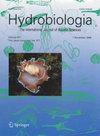Injuries caused by the invasive armoured suckermouth catfish Pterygoplichthys sp. in three captive Antillean manatees Trichechus manatus manatus
IF 0.3
4区 生物学
Q4 MARINE & FRESHWATER BIOLOGY
引用次数: 0
Abstract
Background. The interaction between Pterygoplichthys and Florida manatee (Trichechus manatus latirostris) was recorded approximately 13 years ago in Florida, United States. In Mexico, this interaction has not been documented neither in the wild nor in captivity. Until now it was supposed that Pterygoplichthys attach to manatees to forage the epibiota of the skin without causing any damage. However, some behaviour displayed suggests pain, stress, and discomfort when these fish attach to the manatee’s skin. Goals. To determine if the skin wounds found in three captive manatees are associated with the presence of Pterygoplichthys in the facilities where they are housed. Methods. By trawling a large artificial lagoon (AL) for three consecutive days, every six months for two and a half years we decimated the local population of Pterygoplichthys; in the management pool (MP), fish were removed manually. Additionally, we reduced the time individuals spent in the management facilities by releasing them into the AL. Results. Total disappearance of the skin wounds was achieved in three years, due to their decreased interaction with the catfish (both through the reduction of the population of Pterygoplichthys and of the time spent by the manatees in the MP). Conclusions. Injuries were caused by the fact that manatees lived in a small space, without food available for the catfish, which caused an increase in the frequency and aggressiveness of the encounters. Therefore, we recommend creating and implementing strategies to reduce Pterygoplichthys populations in places where manatees inhabit, because in the future the wounds they cause could be a potential threat for the long-term population viability of the endangered Antillean manatee.入侵甲状吸嘴鲶鱼Pterygoplichthys sp.对三只圈养安的列斯海牛的伤害
背景。近13年前,在美国佛罗里达州记录到翼鱼与佛罗里达海牛的相互作用。在墨西哥,无论是在野外还是在圈养环境中,都没有记录到这种相互作用。到目前为止,人们一直认为翼鱼附着在海牛身上,觅食海牛皮肤的表层生物,而不会造成任何伤害。然而,当这些鱼附着在海牛的皮肤上时,它们表现出的一些行为表明了疼痛、压力和不适。的目标。为了确定在三只圈养海牛身上发现的皮肤伤口是否与饲养它们的设施中存在翼鱼有关。方法。我们用拖网在一个大的人工泻湖(AL)上连续拖三天,每六个月拖三天,连续两年半,我们把当地的翼鱼大量捕杀;在管理池(MP)中,人工去除鱼。此外,我们通过将个体释放到人工智能中,减少了个体在管理设施中花费的时间。皮肤伤口在三年内完全消失,因为它们与鲶鱼的互动减少了(通过翼鱼种群的减少和海牛在MP中度过的时间)。结论。造成伤害的原因是海牛生活在一个狭小的空间里,没有食物给鲶鱼,这导致了遭遇的频率和攻击性的增加。因此,我们建议在海牛栖息的地方制定和实施减少翼鱼种群的策略,因为在未来,它们造成的伤害可能会对濒临灭绝的安的列斯海牛的长期种群生存能力构成潜在威胁。
本文章由计算机程序翻译,如有差异,请以英文原文为准。
求助全文
约1分钟内获得全文
求助全文
来源期刊

Hidrobiologica
生物-海洋与淡水生物学
CiteScore
0.40
自引率
0.00%
发文量
8
审稿时长
>12 weeks
期刊介绍:
HIDROBIOLÓGICA es una publicación cuatrimestral que difunde trabajos originales e inéditos de investigación o revisión, sobre temas relacionados con los organismos y la hidrología de los ambientes acuáticos, dulces y marinos y va dirigida a investigadores de todo el mundo, interesados en las diversas disciplinas que incluye la Hidrobiología , así como a alumnos de posgrados y licenciaturas relacionados con la biología, ecología, taxonomía, filogenia y evolución de organismos acuáticos, e hidrología y oceanografía de ambientes s dulceacuícolas y marinos.
 求助内容:
求助内容: 应助结果提醒方式:
应助结果提醒方式:


